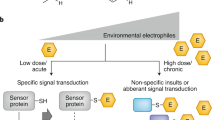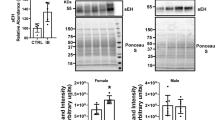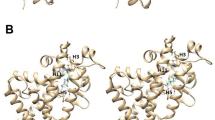Abstract
Polyhalogenated hydrocarbons are widely distributed environmental pollutants. Several members of the class, including certain polychlorinated biphenyls (PCBs) and polychlorinated dibenzofurans and dibenzodioxins, produce a characteristic toxicity syndrome, manifestations of which are increased mortality, oedema, hyperkeratosis, thymic involution and hepatotoxicity1,2. The toxic hydrocarbons are also inducers of cytochrome P448-mediated mixed function oxidases2,3. The toxicity and induction responses both involve initial binding of the hydrocarbon to the same cytosolic receptor3, but the subsequent events are not understood. It is not known, for example, whether the toxicity and induction are causally related, or whether they are coordinated but independent aspects of a pleiotropic response3. Here we report that benoxaprofen, a nonsteroidal antiinflammatory agent, decreases the toxicity of a PCB isomer, 3,4,3′,4′ tetrachlorobiphenyl (TCB), in the chick embryo and that it does so without altering the degree of mixed function oxidase induction. The independent alteration of PCB toxicity and induction suggests that the two phenomena are not causally related. The decrease in toxicity by benoxaprofen suggests further that products of arachidonic acid metabolism or other mediators of inflammation may have a causal role in halogenated hydrocarbon toxicity.
This is a preview of subscription content, access via your institution
Access options
Subscribe to this journal
Receive 51 print issues and online access
$199.00 per year
only $3.90 per issue
Buy this article
- Purchase on Springer Link
- Instant access to full article PDF
Prices may be subject to local taxes which are calculated during checkout
Similar content being viewed by others
References
Kimbrough, R. CRC crit. Rev. Tox. 2, 445–498 (1974).
Goldstein, J. A. in Halogenated Biphenyls, Terphenyls, Naphthalenes, Dibenzodioxins and Related Products (ed. Kimbrough, R.) 151–190 (Elsevier, Amsterdam, 1980).
Poland, A. & Knutson, J. C. A. Rev. Pharmac. Tox. 22, 517–554 (1982).
Yoshimura, H., Yoshihara, S., Ozawa, N. & Miki, M. Ann. N.Y. Acad. Sci. 320, 179–192 (1979).
Silkworth, J. B. & Grabstein, E. M. Tox. appl. Pharmac. 65, 109–115 (1982).
Poland, A. & Glover, E. Molec. Pharmac. 9, 736–747 (1973).
Burke, M. D. & Mayer, R. T. Drug Metab. Disposition 2, 583–588 (1974).
McCormack, K. M., Cagen, S. Z., Rickert, D. C., Gibson, J.E. & Dent, J. G. Drug Metab. Disposition 7, 252–259 (1979).
Shoya, S., Horiuchi, T. & Kohanawa, M. Natn. Inst. Anim. Hlth Q., Tokyo 19, 53–64 (1979).
McConnell, E. E. in Halogenated Biphenyls, Terphenyls, Naphthalenes, Dibenzodioxins and Related Products (ed. Kimbrough, R.) 109–150 (Elsevier, Amsterdam, 1980).
Cashin, C. H., Dawson, W. & Kitchen, E. A. J. Pharm. Pharmac. 29, 330–336 (1977).
Walker, J. R. & Dawson, W. J. Pharm. Pharmac. 31, 778–780 (1979).
Ford-Hutchinson, A. W., Walker, J. R., Connor, N. S., Oliver, A. M. & Smith, M. J. H. J. Pharm. Pharmac. 29, 372–373 (1977).
Kohli, K. K. & Goldstein, J. A. Life Sci. 29, 299–305 (1981).
Shen, T.-Y. and Winter, C. A. Adv. Drug Res. 12, 89–245 (1977).
Chatfield, D. H. & Green, J. N. Xenobiotica 8, 133–144 (1978).
Dutton, G. J. & Ko, V. Biochem. J. 99, 550–556 (1966).
Poland, A. & Glover, E. Molec. Pharmac. 17, 86–94 (1980).
Blumer, J. L. & Frank, D. M. Fedn Proc. 40, 745 (1981).
Author information
Authors and Affiliations
Rights and permissions
About this article
Cite this article
Rifkind, A., Muschick, H. Benoxaprofen suppression of polychlorinated biphenyl toxicity without alteration of mixed function oxidase function. Nature 303, 524–526 (1983). https://doi.org/10.1038/303524a0
Received:
Accepted:
Published:
Issue Date:
DOI: https://doi.org/10.1038/303524a0
This article is cited by
-
Action of methotrexate on cytochrome P-450 monooxygenases in rats
European Journal of Drug Metabolism and Pharmacokinetics (1994)
-
Ethoxyresorufin O-deethylase (EROD) and aryl hydrocarbon hydroxylase (AHH)-inducing potency and lethality of chlorinated naphthalenes in chicken (Gallus domesticus) and eider duck (Somateria mollissima) embryos
Archives of Toxicology (1994)
-
Microcontaminants and reproductive impairment of the Forster's tern on Green Bay, Lake Michigan-1983
Archives of Environmental Contamination and Toxicology (1989)
-
Effects of PCBs on plasma enzymes, testosterone level, and hepatic xenobiotic metabolism in the grey partridge,Perdix perdix
Bulletin of Environmental Contamination and Toxicology (1989)
-
Effects of organic contaminants on reproduction of the starry flounder Platichthys stellatus in San Francisco Bay
Marine Biology (1988)
Comments
By submitting a comment you agree to abide by our Terms and Community Guidelines. If you find something abusive or that does not comply with our terms or guidelines please flag it as inappropriate.



